Don't wanna be here? Send us removal request.
Video
tumblr
A young Elephant Seal trying (unsuccessfully) to convince some Kings to get out of his way.
THE END (????)
1 note
·
View note
Photo



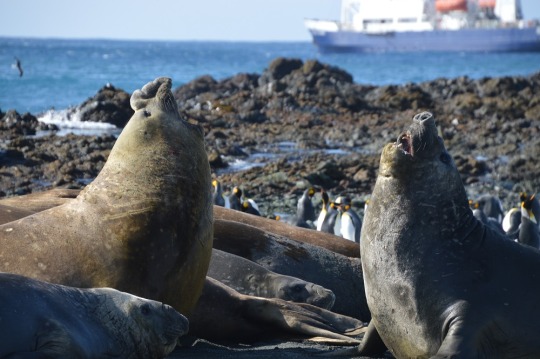

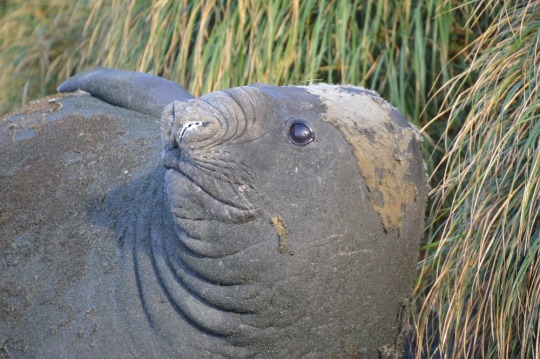
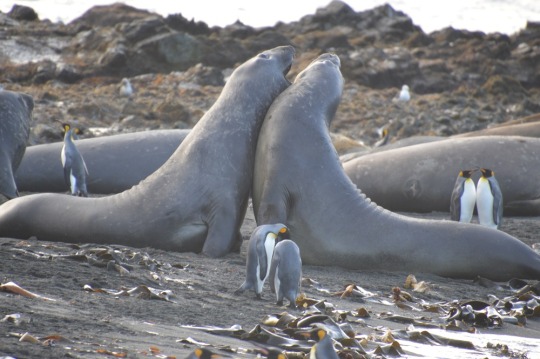
King Penguin colony and some really scary teenaged Elephant Seals (only a mother could love them). Note the size comparison with the King Penguins in the last pic - with the Seals practising their intimidation skills.
1 note
·
View note
Photo
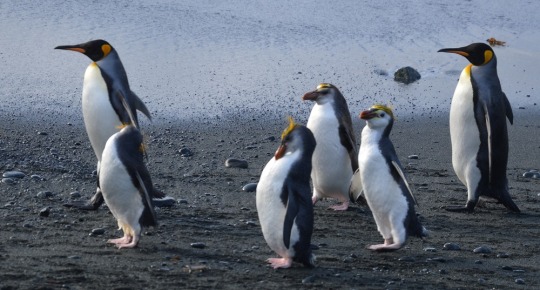




Mum, Dad and the kids??? Definitely not. The two tall ones are Kings and the four smaller ones are Royal Penguins.
Beach scene - Heather engaging with some sunbathers with several great sea-slugs in the background. But the sea-slugs are really Elephant Seals.
Two of only 3 Gentoos we saw and they are not normally on this beach - maybe they heard we were visiting and came for a squiz at us?
And a handsome Royal Penguin who seems to have lost his comb and his hair is all mussed up. They are soooo cute.
1 note
·
View note
Photo
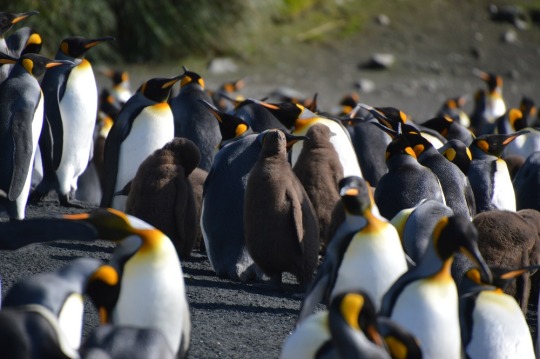
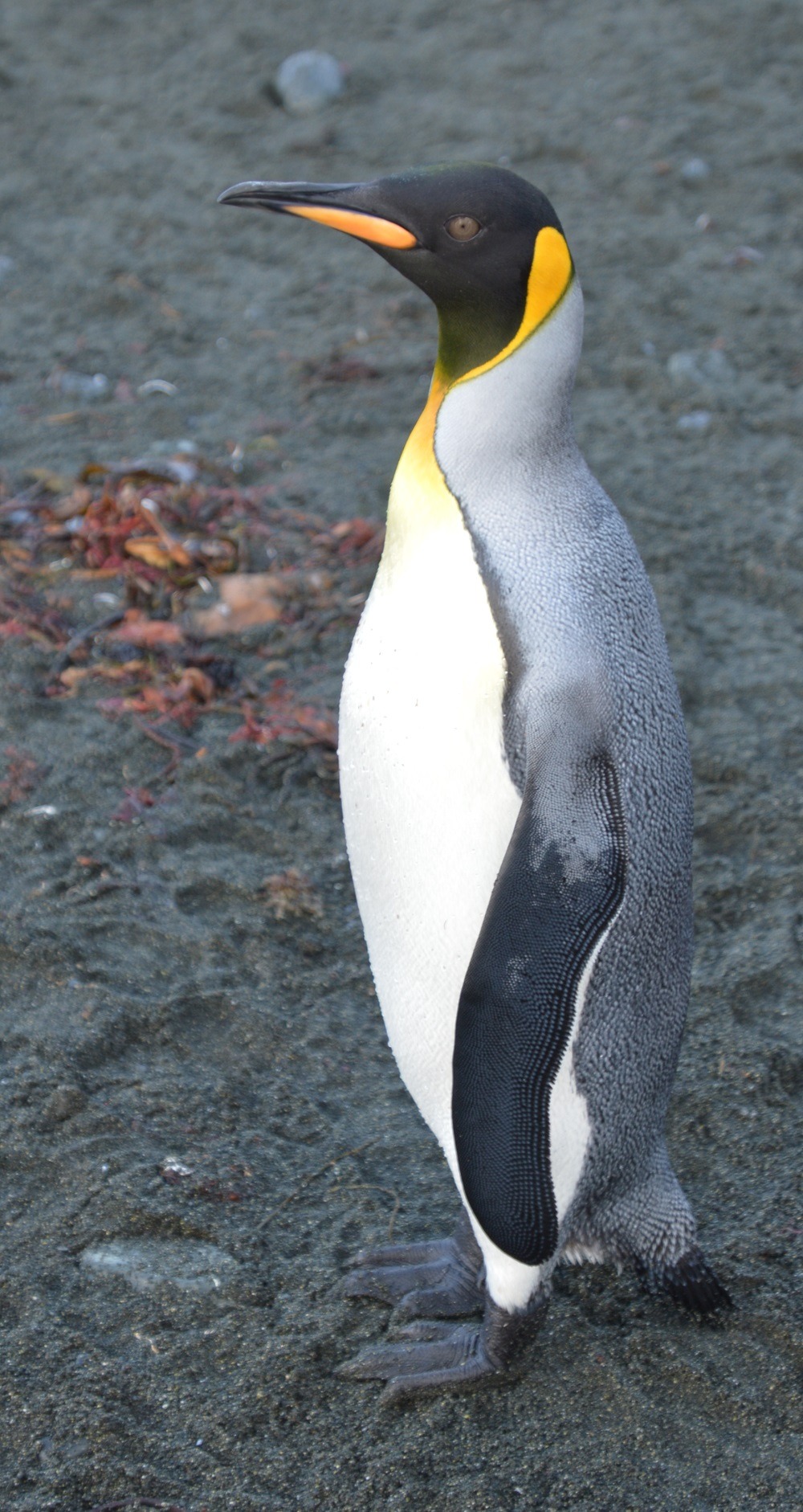


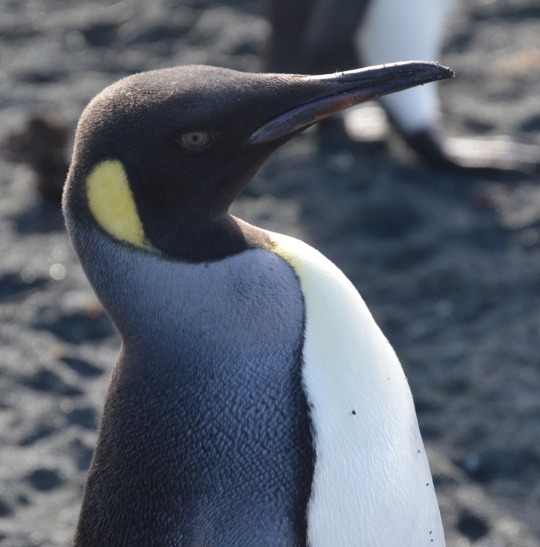
The King Penguin colony at Sandy Beach, with some fluffy brown chicks in the middle. Some cute portraits of these magnificent birds - and the last one is more probably still only a Prince. He is a juvenile (note different colour and bill) and will very soon be a King, just like all the others. (They were sometimes too close to photograph when they waddled up to inspect me, or my camera.)
1 note
·
View note
Photo

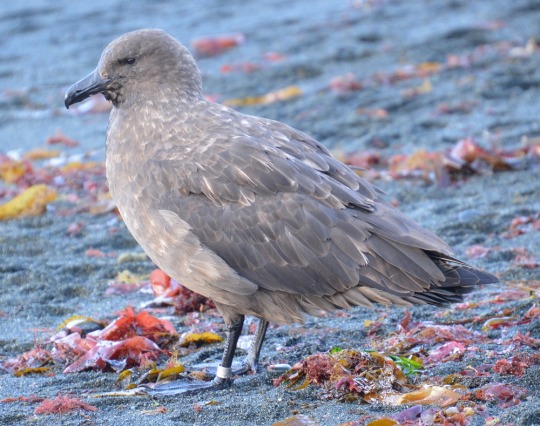

Starting with....
A bird in the hand - this tiny Fairy Prion took on the ship and knocked himself senseless. Fortunately, he survived and revived and was soon on his way back to join his friends.
Then we have a banded South Polar Skua and a Southern Giant Petrel (Brown morph). I posted a white morph from the previous day’s zodiac cruise a week ago.
1 note
·
View note
Text
Addendum
Sorry about this, but I have found a ‘compelling reason’ to add something to my blog! It seems that I failed to post a bunch of photos I took on Macquarie Island. Stand by, they are coming any minute now!
1 note
·
View note
Text
Monday 9 March Day 32 Home Sweet Home
We were up before the alarm woke us and basically just dressed and walked out the door with our baggage (that we had packed the night before). We trekked across the carpark again to the Air New Zealand counter (fully automated check-in and baggage routine) and were through Immigration and Customs in no time. The more we travel, the more I realise that other countries do airports at least a dozen times better than the offensive nightmare that is Australia!
I finished reading another book on the plane and then wrote a bit for this blog and then we were tracking across Phillip Island on the way to Tullamarine. Immigration was confusing but perhaps not quite as painful as normal then it was baggage collection – with constant PA broadcasts advising us that the baggage carousel for our flight was experiencing technical issues and would be fixed in 5 minutes, then another 5 minutes, then another 5 minutes….. Eventually our second case arrived on a different carousel and we headed for Customs. The queue was hundreds of metres long but moved surprisingly well. We had declared a few things, mainly about being in wilderness areas, but they just asked Heather if her shoes were clean and waved us both through.
Back in Australia again to the welcoming sight of our smiling limo driver Nick who had been cooling his heels for about an hour. Our wonderful travel agent Bev from Travelmanagers arranged for Nick to take us to and from the airport as a bonus – thank you Bev, it was wonderful and Nick is great. He just takes control of our bags and all and we ride home in luxury.
We were home in our own little pad by about 10am and had the kettle on for a cuppa before doing anything. We had completed a journey of 9280 kilometres by ship and perhaps 100 or so by zodiac. We flew 5278 kilometres and travelled close to 400 on land - more than 15,000km all up! After that, I figured we deserved a cuppa!
We were in no hurry to unpack but did it slowly over a few days and we dealt with the surprisingly small accumulation of mail and of course email pretty easily. Then the coronavirus turned the world upside down and chaos descended – in my view, largely unnecessarily.
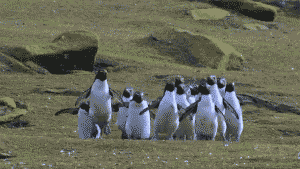
A few impressions It is very hard to condense almost 5 weeks’ experience into a few sentences, but there were a few aspects or blocks of time that warrant some comment.
One BIG highlight was walking on a new continent – and of course, setting foot on remote Antarctica in places where so few people have been, is a bigger deal than walking almost anywhere else on earth. I have often wondered if it is still possible to place one’s foot on any part of the earth that has not been trodden on before. I doubt if this happened in Antarctica, but I had a sense that tramping around on Enderby Island may just feasibly have made this possible – mainly because it had no history of an indigenous population and the farming that did occur there was relatively less invasive - so a few square inches may never have previously experienced the tread of a human foot. Who knows, but I have often thought about it and this gave me a buzz.
The scenery was unique, wild and rugged and so much in monochrome – black rocks and white snow. Obviously, there was the sky and the sea and the islands, but there was stark beauty, high drama and awe-inspiring majesty every day unmatched anywhere else.
Having said that, the magnitude of the huge frozen continent and our uninterrupted day-after-day traversing of the furious but featureless sea was also awe-inspiring (despite a touch of sea-sickness). Who could imagine a hidden continent more than twice the size of Australia, a sea that goes on forever (and ever), ice-blocks the size of France, giant whales displaying just for us, the number and variety of birds and mammals, but no visible fish, reptiles, even insects (except on one island), vast tracts of land with not a leaf, a blade of grass or other plant? So much seemed alien even when we were immersed in it.
I loved the birds (of course) with the albatrosses and snow petrels perhaps being my favourites. Ten or eleven species of Penguin – I still need to do a little more work on my list, but I think I saw at least 96 different species altogether, close to 40 of which I had not seen before. [PS: Have just finished my analysis and note that the exact figures should have been..... Total species seen = 123 – 28 in Australia (Macquarie Island or nearby waters) and 95 in NZ. (I saw some in both areas). These include 26 new additions (species not previously seen) to my Australian list and 50 for my NZ list.
The expedition focussed heavily on the historical side of the region, specifically the huts built by the explorers in the Heroic Age of Exploration that concluded a shade more than a century ago. I expected a much stronger focus on the wildlife (fauna AND flora), but in retrospect, the range of possible sightings was very restricted for about half the voyage and there was very little opportunity to see a lot of flora, so perhaps I am being unfair. I am delighted that so much of the continent and the Sub-Antarctic Islands are free (or have been freed - thank you New Zealand) of feral species and are being vigorously protected against future invasion as far as possible.
The huts are exceptional relics of (relatively) recent history in a tangible form so I am glad they are being preserved in their pristine condition. They are much bigger and more substantial than my previous reading suggested, but having seen them, I appreciate that they probably needed to be something close to this given the elements, the privation and the potential to be marooned there over winter or longer. And retaining them exactly as they were when the early explorers closed the door behind themselves gives them an immediacy and authenticity that is unique in other historical monuments – as if one of the original inhabitants could meet you there and discuss the problems he had endured and the challenges he had overcome that very day.
The long days at sea and the fury of the elements should have been expected but were a bit wilder than I anticipated, but taken as a whole, the experience was unique and given the opportunity, I would do it all again, albeit perhaps with some minor modifications in terms of preparation and expectations.
Epilogue Unless something compelling arises, this is the end of this blog. But I expect there will be another - lindoig6.tumblr.com in all probability, starting in the middle of May and continuing our caravan exploration of Australia’s outback, ticking off a few more isolated stock routes and iconic dirt roads. I will send you an invitation to follow those adventures too in due course.
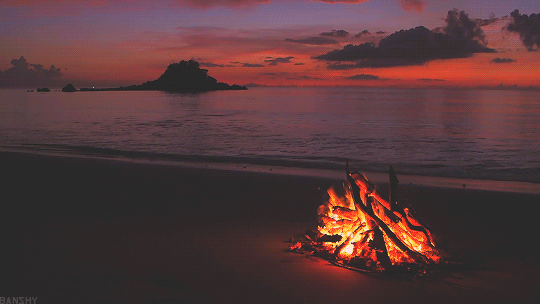
1 note
·
View note
Text
Saturday/Sunday Days 30 & 31 The final dash for Lyttleton and Christchurch
Saturday - at sea They promised us a calm voyage up the west coast of NZ to Lyttleton: the port of Christchurch. Well, they got that one wrong(!!!) and we were buffeted around almost all the way from The Snares to the port. It was the last day (and two nights) of the expedition and it was all at sea. There was a lot of administrative tasks to fill the day, with packing and preparing for land, paying shipboard accounts, returning borrowed gumboots and life jackets and so on.
They had a really great final recap session in the afternoon with a comprehensive review of our voyage and answers to many more questions. Dan had produced a wonderful 27-minute video featuring most of the highlights of the trip and they premiered that during the session. (We were all given a copy of it, along with a timeline and some great maps of our voyage, on a USB stick when we left the ship.) He is a great photographer and the whole video is a truly brilliant reminder of so many aspects of the trip. It is also a great way for us to show people what the trip was like in quite a condensed and very visual format. We have shown it to some of our kids and the trouble is that as it plays, we keep wanting to pause it to elaborate or explain the experience, or add something of our personal touches to it.
There were also lots of thank you speeches – for each member of the staff, the Russian crew, even for us expeditioners. A particular highlight was a thank you to David Harrowfield, the historian who was retiring from guiding after 51 trips to the Antarctic. The whole wind-up session was all very emotional for most people. We had all contributed donations that we gave to David to pass on to the Antarctic Heritage Trust that works on the historic restoration projects down there.
Sunday Christchurch The ship found a relatively calm anchorage overnight, but set off again quite early today so we arrived in Lyttleton as soon as the pilot could get us into the port. Then it was getting our passports stamped by Immigration and a sign-off by Customs, lots more ‘thank yous’ and a few emotional farewells to staff and numerous passengers and eventually onto the bus to take us for a surprisingly long trip into the Christchurch city centre where quite a few alighted. We stayed on the bus with quite a few others who were heading to the airport (another fair distance) for flights later in the day.
At the airport, we collected our bags from the bus and trekked the 50 metres across the carpark to the Novotel where we were staying overnight. Fortunately, despite the early hour, we were able to get straight into our very comfortable room and enjoyed a leisurely cuppa and a sit down before even opening our bags. We did a minimum of organisation and set off to walk to the International Antarctic Centre half a kilometre away. (The Novotel is in a great location. We had been dropped virtually at the door, the Antarctic Centre that we really wanted to see was an easy walk away, and the airport check-in was only a hundred metres or so in the opposite direction.)
The Antarctic Centre is quite fabulous with lots of history and natural history exhibits, and hands-on experiences enough to fill in several hours. There is a penguin display where several rescued Little Penguins (aka Fairy or Blue Penguins) and New Zealand’s White-flippered Penguins were being fed. They have a realistic ‘Antarctic Experience’ a few times a day where tourists can get rigged out (much as we were in the wild) and enter a big room at -18 degrees with snow and gale-force winds, etc. You have to pay extra to do that and having just spent days doing it in real life, we elected not to participate in that one. There is also an area where you can get smashed about as if in a ship in a storm, but again, we had the bruises to prove we didn’t need to do that again.
It is an outstanding museum, crammed full of memorabilia, exhibits, information boards and hands-on devices and we enjoyed it immensely. Definitely worth visiting if you are ever near Christchurch. We had a pie (had been hanging out for some really good food!!) in a poorly-serviced dining area then returned to the display area to explore a bit further and watch a couple of excellent videos. There was a massive screen showing a 17-minute loop of life in Antarctica and another much longer one about a year at the McMurdo Base. It ran for well over an hour and was very US-centric, but we watched it all and it was excellent.
Back in our room, we relaxed for a while and took advantage of the free Wi-fi and fired off a few quick emails, mainly to the family. I had nearly 700 waiting for me – fortunately mostly spam but I still had to look through them to retrieve the kosher ones that had been placed in the spam folder in error. We had heard about the crazy panic buying of toilet paper in Australia so we slipped one roll from the hotel into our baggage in case we arrived home to find our apartment burgled and all our rolls stolen. This was just before the world finally imploded completely: an event that our return to Australia seems to have precipitated. Madness!
We had booked an early meal in the Novotel restaurant and it was excellent – much better than anything we had on the ship with the possible exception of one excellent Sunday roast dinner. Then an early night with the alarm set for 3am – that is not yet another typo – it really was 3am.
1 note
·
View note
Photo
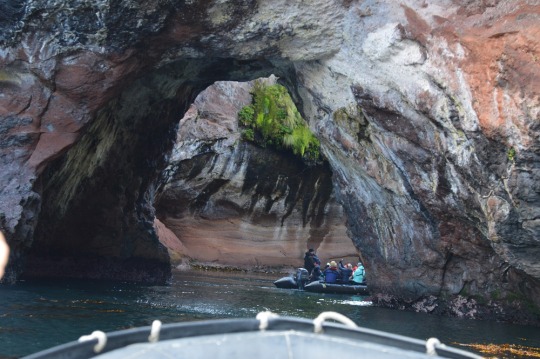





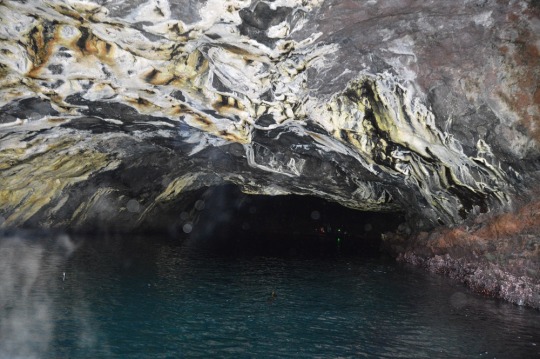


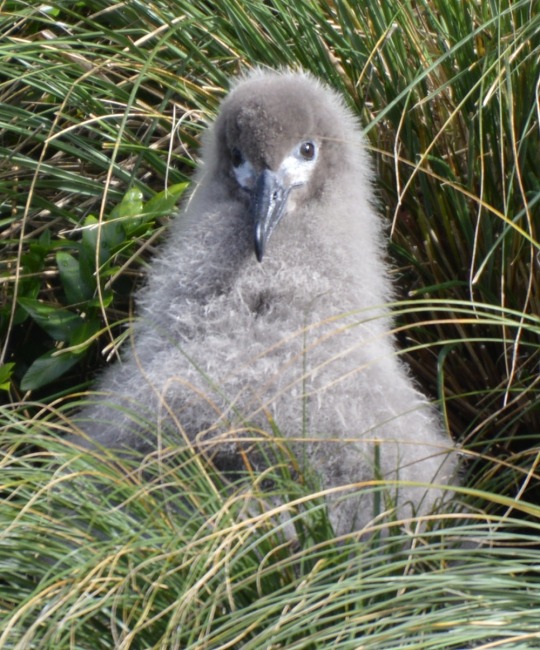
Enjoy these - they are my last photos for this blog. (And sorry, but a couple of them don’t synch with the blog - I should have posted them a day or two earlier.)
Starting with us entering then cruising the volcanic crater, and Heather trying to GoPro the mischievous but uncooperative Sea-lion inside. Outside the cave but with the beasty still sneaking up on us. The entrance to and exit of the second cave/tunnel and the rocks in the roof.
A pair of white-fronted Terns, two courting Light-mantled Sooty Albatrosses and one of the estranged chicks.
1 note
·
View note
Text
Friday Day 29 The Snares
Overnight, the ship transported us to The Snares: another of New Zealand’s wonderful Sub-Antarctic islands, but one on which it is forbidden to land. It is now feral-free and the authorities are justifiably eager to keep it that way so no human pests are allowed to land. This is to avoid the risk of us reintroducing any unwanted flora or fauna back onto the island.
Instead, we enjoyed a wonderful zodiac cruise. We cruised along very close to the shoreline for a kilometre or so as more albatrosses (and other birds) wheeled around above us, then entered another long sea-cave – this one more likely not a lava-tube. We puttered in quite a long way, getting darker and darker as we went, but then saw some light at the end of the tunnel. Turning to port (left for you landlubbers) we cruised right out into bright sunlight further along the coast and around the corner from where we started our little journey. The cave/tunnel itself was quite interesting with mainly green walls and ceiling but also reds and browns from different types of algae.
We followed along the coast, exploring several tiny inlets as we went, then rounded another corner into a colony of Snares Crested Penguins, accompanied by 20 or 30 Seals and Sea-lions, lazing around on the rocks and ogling the strange new species drifting past them on the water. A group of 3 Fur-seals seemed to be having some sort of violent altercation in the water near our zodiac. Maybe they were just playing, but they were splashing and leaping and diving and lunging at each other for several minutes before they resolved their differences – or took their fight further away from us.
Dan thought one of the most distant penguins looked a bit different from the others but eventually concluded that they were all the same. But some of my photos subsequently proved him wrong. A single bird on the extreme right of the colony was an Erect-crested Penguin, the only one anyone saw anywhere on the voyage.
We cruised further around the bay and saw some more great birds – Auckland Island Shags and Black-billed, Red-billed and White-fronted Terns, several lovely Tuis, numerous unique all-black Auckland Island Tomtits, a few Fernbirds and lots of Bellbirds. Most of them let us get relatively (or very) close to them and then there were the Light-mantled Sooty Albatrosses with their strange eye patterns – two Adults and two chicks, all together on a ledge not far out of our reach - but the surprising thing is that the adults were not the parents of the chicks. They were a courting pair and it was wonderful to watch them dancing and bill-clacking before going off to do some formation flying that was great to watch. They were joined by a third Sooty (apparently quite common) and it was like synchronised swimming in the air as they swooped and glided and wheeled and soared as if joined by invisible threads. The chicks were close to fledging and their parents were nowhere to be seen, but would presumably be back to feed the chicks after we left the area. We saw a few more Seals and Sea-lions before returning to the ship across some challenging sea but it had been an exceptionally wonderful and educational couple of hours of nature study. And to top it all off, there was the most spectacular rainbow over the ship as we returned for showers and lunch.
According to my notes, during the afternoon, they screened an interesting documentary, but unfortunately, I didn’t record what it was about. I am pretty sure it was a nature doco, but beyond that……
And after dinner, the woman who ran the music quiz a couple of nights earlier did a similar one. She apparently does these quite regularly at home so had another one all cued up on her PC and Heather and I went to this one. There were four teams and the final scores were something like 120, 100, 99.5 and 99 with only half a point separating the non-winners. Both the female cops were in the winning team (as they had been for the previous quiz) and our team came third. One of the cops’ husband (interesting question as to where the apostrophe should be in cop’s’ – I am sure he was only married to one of them!) was on our team and shouted out the answers to several questions so everyone got them right – he is a very extroverted accountant and you just can’t trust accountants!
1 note
·
View note
Text
Thursday Day 28 Ship-cruising the fiords
The ship stayed close to shore for most of the night, but when it moved a little further south in the early morning, our sleep was broken as we rolled around our bunks again in time with the ship.
We were on board all day, but the ship cruised three of the Auckland Island fiords. It was a very grey day with sporadic rain showers but we were probably better off in the fiords because it was quite rough out in the sea proper.
We explored the Chambers and Musgrave Inlets before going further south deep into the long Carnley Harbour more than halfway across the island. Most people were on the Bridge for a good deal of the day, but like us, most also escaped to their blogs and books in the bar or their cabins from time to time. There was not a lot to photograph so hiding out in a warm cabin waiting for lunch or dinner offered some attraction too.
Before Happy Hour and dinner, we had another really good Recap Session with lots more questions answered, this time focussing less on the history and more on the wildlife and environment, presumably because we were now well away from Antarctica where that had been a major focus.
After dinner, the ship headed for our last point of call in fairly rough seas so most people had very broken sleep again. All this expeditioning has turned out to be hard work and we will probably arrive home bruised and battered but with any luck, marginally fitter than we were a month ago.
1 note
·
View note
Photo




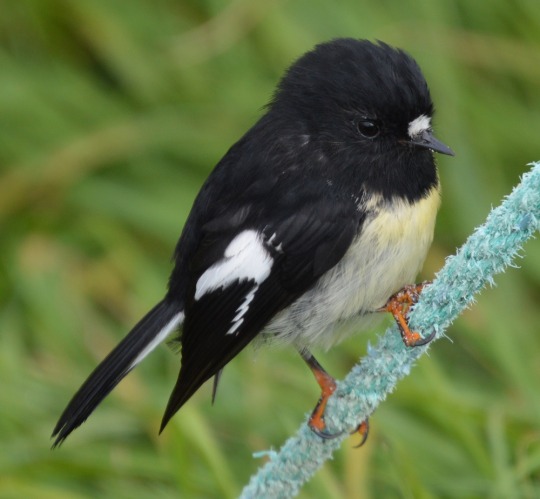



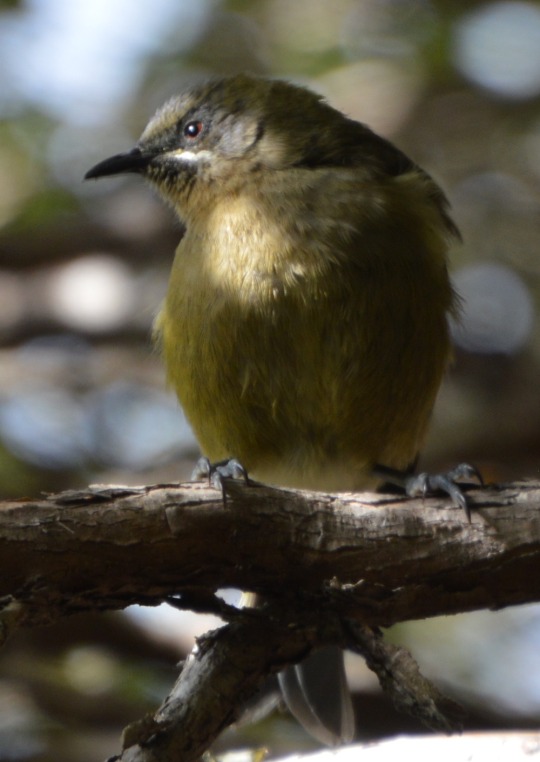
Auckland Island locals. Grumpybum the Sea-lion, a flightless teal and a bellbird, maybe Mrs Grumpybum(?), a Tomtit, a NZ Pipit and a Royal Albatross, a Yellow-eyed Penguin and another Bellbird.
1 note
·
View note
Text
Wednesday Day 27 Beautiful Auckland Island
After a blissfully calm night, we started with a visit to Hardwicke in Erebus Cove in Ross Harbour. A shot zodiac ride to an almost dry landing where there was a short boardwalk up to a small historical graveyard and then a ramble through the trees to the stump of the Victoria Tree. (I almost expected a Hobbit to accost me along the way.) This stump with its carved inscription is all that remains of a cache of supplies left there to assist ship-wrecked sailors cast away on Auckland Island. Apparently a few such caches of basic essentials were set up, mostly during the 19th Century, on some of the remote islands, with signage along the coast to indicate to shipwrecked sealers and whalers (and others) which way to walk to find them. En route to the tree, we encountered a few fur seals resting beside the track and posing for photos. We also saw a few more small land birds, having only seen the Redpoll on ‘Macca’ since leaving Campbell Island 3 weeks ago.
We did a short zodiac cruise along the coast and then returned to the ship while it moved a little way from our overnight anchorage, but then reboarded the zodiacs to cruise around Ranui, another wonderful part of Ross Harbour. Due to a weird mix-up, Heather and I ended up in different zodiacs so we probably saw a few things differently, but it was all a lot of fun.
It was pretty rough getting from the ship back into the lee of the island, but it was wonderful once we arrived. We cruised into a little bay and through a sea-cut archway into the fantastic crater of an extinct (I think) volcano. It was a unique experience going from some pretty rough and turbulent water into such a beautiful grotto a mere few metres away. The water was absolutely crystal-clear and we could see the several metres to the bottom with all its kelp and other sea-life – starfish, jellyfish and so on. I even saw half a dozen little minnows a couple of centimetres long: the only other fish we saw on the entire voyage. A big Sea-lion put on a display for us, repeatedly coming up to the zodiacs and diving under to surface again beside one of the other craft and back again. It followed us around for at least half an hour and Heather tried to photograph it underwater with our GoPro, but it just wouldn’t cooperate.
We cruised deep into a nearby sea-cave (possibly an ancient lava-tube) where it was almost completely dark and we motored around in there, marvelling at the crazy textures and colourful patterns in the rocks above and around us. A couple of torches helped us see a bit, but it was really too dark for photography.
Back on the ship I spent a surprisingly wonderful hour or so on the bow deck all alone. The sun was shining and the sea was temporarily calm and although there were a few people on the Bridge, there were very few, and none in the bow where it was often quite crowded (if the weather allowed). I was just communing with nature and watching the birds, mainly the wonderful albatrosses skimming the waves and wheeling back to do it all again. It was one of the most relaxing and peaceful hours of the whole trip for me – maybe just the chance to do my own thing with nobody else around.
In the afternoon, we landed on a beach called Sandy Bay on exotic Enderby Island (part of the Auckland Island group protecting the mouth of Ross Harbour) and had 4 whole hours to just wander and explore. Heather and I went off on our own, occasionally bumping into other explorers, but we just roamed the hillsides looking at the plants and birds, the Seals and Sea-lions, photographing the rare Yellow-eyed Penguins, lots of Giant Petrels and Albatrosses (mainly Royals and Light-mantled Sooties) as well as the tiny Tomtits that happily sat half a metre from the end of my lens, and lots of Bellbirds. There was a lot of birdsong, but the Bellbirds were actually very hard to find even when they were only 2 or 3 metres away in the vegetation. There was a lot of long grass and even trees on Auckland Island: another thing we had not seen since Campbell Island.
A special bird I saw was the Auckland Island Flightless Teal: another rare bird that almost became extinct until New Zealand launched its excellent and highly successful pest eradication program. I knew the teal were starting to recover so I was looking for them and saw one in quite a small sunken pond when the others were photographing penguins. I got a few photos but when I told the others, they came to look too – and it had completely disappeared. The pond was less than 50 square metres, but the banks were slightly overhung and the teal had obviously found cover somewhere very cleverly. A few people did see teal later when one of our naturalists found two in a tiny inlet near the zodiac pick-up site.
We tramped around over quite a large area, managing to avoid a few big male Sea-lions that can become a bit dangerous. They rest quite widely in the area, including in the trees, so when I was in there looking for birds, I had to be careful not to disturb them. Eventually, Heather decided to take the zodiac ferry back to the ship, but I still had an hour before the last zodiac left. Dan suggested I trek across the island on the boardwalk because he had just come back from photographing some Royal Albatrosses along the route. I was a little concerned about timing – could I get there and back before the last zodiac? Dan said that Agnes (the other main naturalist) and some others were on the other side of the island so I had plenty of time and would encounter them on their way back before I ran out of time anyway so off I went. It was a wonderful trek through the trees, the lower scrub and then the grassland and I passed a couple of others from the ship but never saw Agnes. I photographed some more Yellow-eyed Penguins close to the boardwalk and at least 20 Albatrosses sitting on the grass or cruising the breeze – they really are extraordinarily beautiful, not to mention graceful and so clever. I got quite close to the cliffs on the opposite coast but couldn’t see anyone in front of me so turned back and eventually arrived back at the zodiac pick-up point – to see Agnes and the others returning from a completely different direction. They had hiked up the coast and crossed back across the island a kilometre or more further north so I would never have seen them even if I had reached the cliffs. But I had thoroughly enjoyed my solo walk and the wonderful birds and plants I had seen along the way – so remote and tranquil.
All in all, it had been a wonderful day, probably almost equalling our day on Macquarie Island a couple of days earlier.
1 note
·
View note
Text
Tuesday Day 26 At sea again and back in New Zealand waters
Despite the sea, we both slept surprisingly well last night and woke to a balmy 7 degrees as we continued to rock and roll on our way to Auckland Island. We went to lectures on Mawson and Penguins during the day, but I was feeling pretty seedy again so gave lunch a miss.
We hadn’t heard a lot about Mawson prior to this, mainly because he wasn’t a key player in the Scott and Shackleton (or Amundsen) expeditions, and because his exploits were along the coast a little west of Cape Adare rather than in the Ross Sea. But in my opinion, Mawson was the guy with the real smarts and had more integrity than any of the others. Scott is made out as the great British hero, maybe even seen as a martyr, but his judgement was really poor on several accounts and his arrogance probably accounted for the death of his whole party.
There were a surprising number of Antarctic expeditions by numerous countries during what is called the Heroic Age of Exploration, many by explorers we have never heard of, but I think the four key leaders were probably Shackleton, Scott, Amundsen and Mawson. For some, it was really just a bit of sport to achieve some personal acclaim. For others, it was fulfilling a career obligation with some science on the side as a bonus, but I think Mawson was a scientist who held true to the ideals of scientific discovery irrespective of the cost.
We had a very useful Q & A session during the afternoon and many of us had questions, both on history and natural history in flavour, that were addressed very well by the staff who were expert in their particular fields. It went for almost 2 hours, seriously impinging on Bar Time, but if Happy Hour had not been so pressing, I am sure we could have kept going for another hour or two. It was very enlightening.
We reached the lee of Auckland Island in time for a much calmer evening meal surrounded by many thousands of birds. We were now far enough north to see a few different bird species and I spent time in the Bridge photographing and trying to identify them. One of the passengers ran a music quiz in the evening but we didn’t participate. I reckoned that the extent of my music knowledge was such that I would be a liability on any team so watched the dozens of wonderful albatrosses instead.
1 note
·
View note
Text
1 & 2 March Days 25 & 25 Back in a little patch of Oz again, if only for a couple of days
Sunday We had yet another very rough night with little sleep but when we arose, it was Autumn already - where has the year gone?
All night, the ship was either bucking so we had to hold on to the sides of our bunks to avoid being tossed on to the floor or rolling and causing us to slide from one end of the bunk to the other. An extra pillow avoided us bumping our heads too severely on the headboard, but next second it felt that we were standing up as all our weight was rocketed down to the footboard and we had to straighten our legs out again. Life on board can certainly be hard work in rough weather. Just moving around the ship was challenging as we ran downhill down the passage only to find ourselves climbing the next few steps or actually going backwards as the ship rose and fell. The passageways all had handrails, but it was still pretty difficult being thrown from side to side if we were carrying anything - like hot coffee! (Despite having some Americans on board, I avoided referring to Autumn as Fall - we had already had quite enough falls!)
We had a late breakfast in much calmer conditions once we managed to get into the lee of Macquarie Island - a little bit of Australia after more than five thousand kilometres in New Zealand. (Only 2137km from Home Sweet Home – almost exactly the distance from Melbourne to Invercargill where we started our Odyssey.) We had a little bit of rain and hail during the day (not a lot), but it was still one of the more enjoyable days. We Zodiac-cruised in three different parts of the Island, but couldn’t land anywhere on the day - there were still coronavirus issues that meant we couldn’t visit the Aussie base there, but we sailed to within a few hundred metres of it so at least we have a few photos.
Our zodiacs took us along stretches of beach with many thousands of King and Royal Penguins, along with a few Chinstraps and Gentoos. There were also many large seabirds, both at sea and ashore. The Skuas and Great Petrels were the vultures on land but I particularly loved the wonderful albatrosses that floated effortlessly past on even the lightest of breezes at sea. There were several species of albatross, but the Southern Royals are simply magnificent. We saw a big raft of busy seabirds in one place and went to explore. They were taking advantage of food stirred up by a large male Orca that was feeding close by. It surfaced quite close to our zodiac a few times, but never close enough for good photos. Even so, it gave us a bit of a thrill to share the water with an animal that could swallow half our zodiac in one gulp.
Monday What a magic morning we had! We landed at Sandy Bay to be met by a couple of enthusiastic Aussie rangers who had hiked down from the Research Station the previous day and stayed overnight in a hut to greet us in the morning, all coronavirus-free!
The beach was crowded with several thousand King Penguins, all as curious about us as we were about them. They came up to us either singly or in small groups and stared inquisitively at us from a metre or less away and posed nicely for photos. There were a few Gentoos there too and they were almost as curious as the Kings.
After a short briefing by the head ranger, we were free to range at will over the nearby hillside and a kilometre or more of beach that also contained maybe 30-odd elephant seals – ‘odd’ being the operative word: huge slugs of blubber up to 5 or 6 metres long and as far around the girth. A few males were practising their fighting techniques, rearing up and slamming into their sparring partner, making the whole beach vibrate. Most of the time they just lay on the beach ignoring us completely, but once one decides to shift position, you had better make room. I saw a small one, probably no more than 4 or 5 tonnes, galumphing up the beach behind Heather - and to see all that blubber in motion, both rippling across its massive skeleton and charging for a rest spot further up the beach, you just make way for it because it won’t go around you. It will simply go over you without even noticing the bump. Heather took my urgent advice and moved out of its path - with alacrity!
We walked south along the beach through hordes of penguins to a creek where a narrow boardwalk started and we took that up the hill to a large breeding colony of King Penguins. There were quite a few Great Petrels and Albatrosses soaring around looking for a feed but the penguins were being protective and the predators, as vigilant as they were, weren’t getting a look in.
Returning to the beach, we walked north to a huge Royal Penguin colony, even bigger than the King Penguin one. We weren’t allowed into the colony because there were quite a few fluffy brown chicks still there, but plenty of birds came out to see us instead. They are so inquisitive and they waddle straight up to you and stare right at you – but we were reciprocating too.
I was quite thrilled to see a few redpolls flying around - the only place they can be seen in Australia. They are cute little European birds that were introduced to Macca as it is called (Macquarie Island) in the very early days of sealing and whaling and have survived and thrived, completely isolated from the rest of the world down here. They are the only land bird on any of the very southerly islands and I saw about 10 of them flitting around, perhaps a few more.
The weather has been amazing throughout the voyage and continued to be throughout the entire trip. We certainly had plenty of gale force winds and quite a bit of snow, but very little rain or hail and almost all our off-ship activities were blessed with good conditions and lots of sunny periods - apparently better than any other voyage for quite a few years.
Back on board though, the afternoon became very rough again with high seas and violent buffeting as we headed north along the coast, past the Australian Base again and out into the wild open sea.
One of our colleagues on board spent most of his time on the Bridge and monitored what was going on. He struck up an association with most of the Russian crew and they explained a lot of technical stuff to him. He said that the inclinometer showed the very worst of the ship’s violent rolling at 42 degrees in each direction - hard to believe, but it was certainly wild.
Irrespective of the actual figure, I was tucked up securely in my bunk, reading and napping all afternoon.
1 note
·
View note